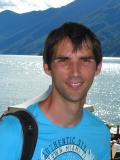Michael Lupberger

Michael Lupberger
Michael Lupberger has studied physics at the University of Freiburg with an ERASMUS exchange year in Aberdeen and a research year at CEA Saclay. He then did his PhD at the University of Bonn in the field of detector electronics for the International Linear Collider. Now, he is a BrightnESS CERN fellow working on the readout system for the NMX prototype that is developed within one of the subtasks in Work Package 4.
- I did my PhD at Bonn University and afterwards the detector team at CERN contacted me, as they needed an expert to work with readout systems for the NMX detector. I then joined CERN as a Fellow in the Gaseous Detector Development group, starting in May 2016.
My main work task concerns the electronics for the detector, whereas my close colleague works on the mechanics. My goal is to implement a new readout chip, which is essential for the high rate of the detector. During my daily work, I therefore mainly sit by the computer, working on software and firmware. There is a large need for this particular chip, for the ESS and the rest of the neutron community as well as in particle physics.
In my Work Package, we have a monthly meeting, which I organise for our subtask. We also have weekly meetings in our own group and we work closely with the people from WP5, as the readout system will be implemented in the ESS data system.
What I like most about BrightnESS is that it is a European project, where I get to collaborate with people from all over Europe. I contribute to the research community in Europe and I feel proud of this.
The key challenge and goal of my work is to implement the chip for the NMX detector. The high neutron rate is challenging, in terms of data rate and thus the readout system. I need to programme the system, to be able to cope with such large data rates. This is a well-known challenge in particle physics, but not so much within neutron research so far.
The ESS and hence BrightnESS is the key project for future neutron research in Europe. There will be a transition from Grenoble to Lund, which will make ESS the next lighthouse for European neutron research. The project is so big, that it will have a very large impact. The new technology is definitely one of the driving forces with so many new detectors that will advance the whole community.

 is funded by the European Union Framework Programme for Research and Innovation Horizon 2020, under grant agreement 676548.
is funded by the European Union Framework Programme for Research and Innovation Horizon 2020, under grant agreement 676548.